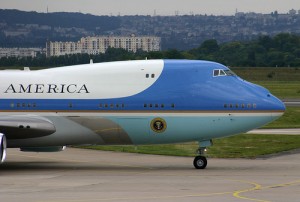
Air Force One (a modified Boeing 747-200), visiting Paris in 2008
Happy President’s Day! I figured this would be a good excuse to take a look at the aircraft that have been used to fly the President of the United States around the world since 1943.
First off, I realize that any US Air Force aircraft the president is in, is called “Air Force One.” For the sake of this post, when I will be talking about the aircraft whose sole mission is to safely fly the President of the United States to his destination, I will refer to this particular aircraft as “Air Force One.”
The first Air Force One has its roots in 1943, when Franklin D Roosevelt was the first president to fly while in office. He flew on a Pan-Am Boeing 314 5,500 miles to Morocco. Previously presidents did not fly, because airplanes were not well equipped with communication devices. That changed for Roosevelt, when the threat of German U-Boats made him think twice about going via boat.
Thinking that commercial air travel was not reliable enough to transport the President of the US, the Air Force converted a Consolidated C-87 Liberator Express to be used to transport Roosevelt on international flights. However, the C-87 was not known for a stellar safety record and the Secret Service refused to let Roosevelt fly on the aircraft. Instead, a Douglas C-54 Skymaster (DC-4) was converted to fly the president around the world. Roosevelt flew on the C-54 Skymaster, called “Sacred Cow”, only once before his death in the spring of 1945. In 1947 Harry S Truman replaced the C-54 with a modified VC-118 Liftmaster (DC-6).
Before an incident in 1953, the president’s aircraft all had standard flight numbers, like any commercial airline flight. The Dwight D Eisenhower administration changed that, when he was flying on Air Force Flight 8610 and an Eastern Airlines flight with the same number received similar orders and got too close to the president’s aircraft. After that, any flight that held the president would be called “Air Force One.”
Eisenhower added the Lockheed C-121 Constellations to the presidential fleet in the mid 50’s and then the Boeing 707 was added in 1958. In 1962, the John F Kennedy administration created the first aircraft used exclusively for presidential travel. The modified Boeing 707-353B (referred to as SAM 26000) had its livery designed by First Lady Jacqueline Kennedy in the familiar blue, silver and white design.
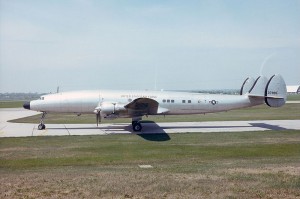
Eisenhower added the Lockheed Constellation to the Presidential Fleet
During the Reagan administration, a new plane was requested for the president. They wanted a minimum of three engines, wide-bodied and a range of at least 6,000 miles. Boeing proposed the Boeing 747 and McDonnell Douglas pushed the DC-10. Boeing won the proposal and the US government ordered two identical Boeing 747-200’s.
The Boeing 747-200’s (VC-25A) were delivered in 1990 to sitting president, George HW Bush and still remain in service today. The VC-25A’s have been retrofitted and interiors re-done multiple times since 1990. The US Air Force Air Mobility Command (USAF MC) is currently looking at a replacement for the aging Boeing 747’s.
In January 2009, the USAF MC stated they would start flying a new Air Force One by 2017. Shortly after the announcement, Airbus stated it would not be bidding on the contract, leaving only Boeing. It is most likely the Boeing 747-8 will be the replacement, however there is talk the Boeing 787 could be the replacement.
What is your favorite Air Force One aircraft or which would be the best one to use in the future?
connect | web | twitter | facebook |
Images: B747 from Three Forty | Constellation from Wikipedia
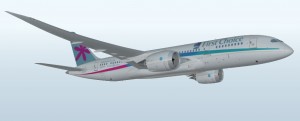
Boeing 787 in First Choice livery. Photo from NewPlane.com
Preview what the Boeing 787 Dreamliner will look like in different airline liveries (scroll down a little bit for the custom liveries). From Aeroflot to VLAC.
It is great seeing the different designs in 3D on the computer screen, but I can’t wait to see them in person (of course you can already see ANA’s livery on the 787).
If the Boeing 787 liveries don’t distract you enough, you can also check out the new Boeing 747-8 Highlights page via Boeing.
Thanks to Sandy at the Future of Flight for finding this!
connect | web | twitter | facebook |
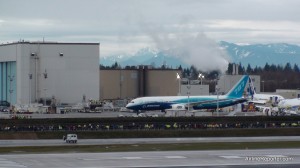
The Boeing 787 on its way to the runway for its first flight yesterday.
The Boeing 787 Dreamliner had a wonderful first flight yesterday. It was covered by multiple media outlets and many different formats, from twitter, to standard live TV, to web feed, to even streaming video on an iPhone. Reading the forums (and even my friend’s Facebook statuses) a lot of people keep asking “why should I care?”
These are the reasons I think even non-aviation nerds might care:
* The 787 is made up of 50% composite material. I have seen people say “I would much rather fly on a metal plane than a plastic one.” The carbon fiber used in this aircraft is not like any plastic. Carbon fiber is stronger and lighter than metal and I would much rather fly in a “plastic” than “metal” plane any day. Take a look at this picture of the inside structure of a Boeing 707. All the metal panels riveted together. Notice all the additional structure needed around the windows. Compare it to the inside of the 787. The 787’s composite body is one solid structure and with fewer weak points. For example, the Boeing 747 requires about 1million holes to be drilled in its fuselage, but the 787 requires less than 10,000. (take a look at all the Boeing 707 and 787 material pictures I took at the Future of Flight)
* Boeing has designed this aircraft to bring back the joy in flying. There is revolutionary lighting and more space for people and luggage.
* The humidity level during flight will be higher, due to having composite materials that won’t rust. This will increase the comfort level for the passengers and reduce jet lag.
* Even with the delays and cancellations, there are still 840 orders for the Boeing 787.
* Due to more efficient engines and less weight, the 787 will reduce fuel consumption and carbon emissions by about 20%. Yet it still is able to go Mach .85, about the speed of its bigger siblings the 777 and 747.
* The aircraft has the largest windows in any passenger jetliner. This will provide a more open feel and give everyone a view to the outside. There are also no sunshades, but just a button which will cause the window to tint and block out the sun, but still have some ability to see outside.
* This plane was made to replace the highly successful Boeing 767. The 787-8 will be able to carry about 210-250 passengers around 8000 nautical miles, while the 787-9 will be able to carry 250-290 about 8250 nautical miles.
* With the 787’s range and ability to land at smaller airports, it will reduce the need for airlines to use hub systems and allow them to provide more non-stop flights. This of course lets passengers spend more time at their destination and less time getting there (however as an airline nerd, I love the process of getting there too, so maybe that is a negative for me?!) – Thanks Ian for pointing that out!
If those aren’t enough, it just looks really cool taking off with its wings flexing.
This is a very exciting time in aviation history. We just had the Boeing 787 Dreamliner take its first flight and now we wait for the Boeing 747-8 to take its first flight, which will probably be in about a month or so, which of course I will be following.
follow | web | twitter | email | rss |
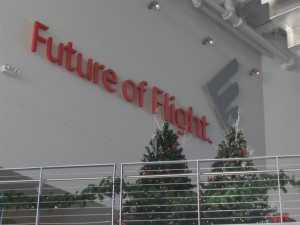
The Aviation Geekfest happened at the Future of Flight. Photo by Airline Reporter
The Aviation GeekFest was amazing yesterday. I got there a little early to enjoy what the Future of Flight has to offer. I was treated to seeing a Boeing 737 doing touch and go’s (can you guess what airline will be getting this aircraft?) from the Strato Deck.
It was nice meeting all the other aviation geeks. It is always great to be around other aviation-minded people and talk in length about the airline business.
After grouping up we were able to get a special VIP tour of the Boeing Factory up in Everett. It was hard because we weren’t allowed to bring in cameras or phones on the tour. Most of us are technology geeks and I wanted to pull out my iPhone about two dozen times to take pictures and Twitter, but I wasn’t able to. Harriet Baskas, who was also on the tour and aviation pro, was lucky enough to smuggle out a drawn picture of the Boeing 787 ZA001. After seeing her nice picture I was happy that Boeing was also kind enough to take pictures of our group during the tour (which I included on my Flickr).
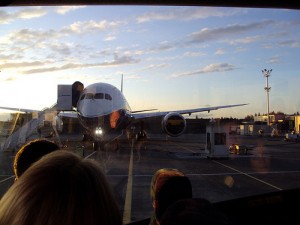
The money shot! Our bus got with-in a few feet of the ZA001 Boeing 787 on the flight line. Its strobes were flashing and one engine spinning. Photo by Boeing
Probably the best part of the tour was being able to drive out on the flight line. Normally the tour doesn’t do this, but we were all about 50 feet away from Boeing 787 ZA001. It had its strobes on and one engine spinning. Pretty much aviation geek heaven. I think most people had goose bumps being so close and I REALLY wanted to have my camera right then. The Boeing 787 just looks amazing that close in person and I can’t wait to see it take flight.
We then went into the Boeing facility where we could see the Boeing 777, 747-8, and 787 being built. It just amazed me how Boeing makes it look so simple to build some of the most complex machines in the world. Seeing all the parts and how complex the process is, it is incredible how these machines are able to fly for 20-40 years with almost no issues. Tour guide Mike (also a Airline Reporter reader, HI MIKE!) did an AMAZING job with his tour and left no question unanswered (except “hey, when is the 787’s first flight?” — although it was hinted it might be December 15th now).
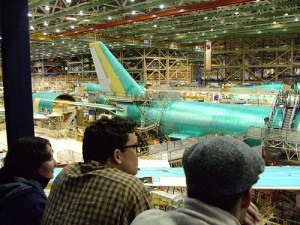
It was great looking out and seeing the new Boeing 747-8 being built. Photo by Boeing
Then it was back to the Future of Flight for some awesome pizza from Garlic Jim’s and beer compliments of Horizon Air. Although I didn’t win any of the raffle prizes (two VIP tickets to the 787 first flight, $250 Alaska Airlines gift certificates, an amazing looking model by Custom Models, and more) I was totally ok with that since it was a great event.
They hope to do it again in the future, so be sure to keep out a keen eye for invites (add everyone listed in the previous paragraph and me to your Twitter account to hear about the next event). A special thank you to everyone who made the event possible and I can’t wait until the next one!
MORE MEDIA:
* Photos from the event
* Twitters of the event (#agf)
* Video shot of Future of Flight by @chasegallagher
follow via | web | twitter | email | rss |
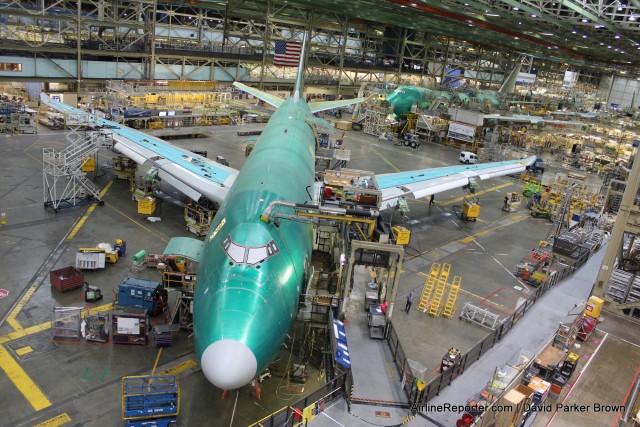
A Boeing 747-8F inside the factory in Everett, WA
What is AirlineReporter?
Welcome, and thank you stopping by, where we love to share our passion for aviation, travel and the airline industry since July 23, 2008. We are a team of writers, located around the world who love airlines. We have flown over 2,000,000 miles to bring engaging content to our readers. Most of us are working professionals, who want to share our passion with you.
There are many negative voices about the airline business out there and we try to provide the context behind the stories. Many people see airlines as an “evil” business and that flying “is not like it used to be.” AirlineReporter tries to remind folks that flying can still be a magical experience and it is not like the way it used to be; in many cases it is better.
We hit a broad audience of aviation fans, frequent fliers, people who work in the airline business, and others in the media that cover aviation. We are proud of the impact we have made with our hundreds of thousands of readers each month and our strong social media presence, with over 120,000 engaged Twitter followers.
We have been on, written for, or quoted on a number of different media sources, including: CNN, Washington Post, BBC, CNBC, Bloomberg, Costco Connection, Reuters, CTV (Canada AM), CBC, NPR, Marketplace, FOX, AOL Travel, 9News Australia, Huffington Post, Forbes, APEX magazine, USA Today, KING5, MSNBC (now NBC News), Puget Sound Business Journal, Seattle Times, Gadling, Alaska Airlines’ Blog, and others.
Have questions? Story ideas? Maybe share your own story? Cool. Email our Editor-in-Chief and Founder, David Parker Brown, directly at da***@*************er.com.
The AvGeeks Running the Show:
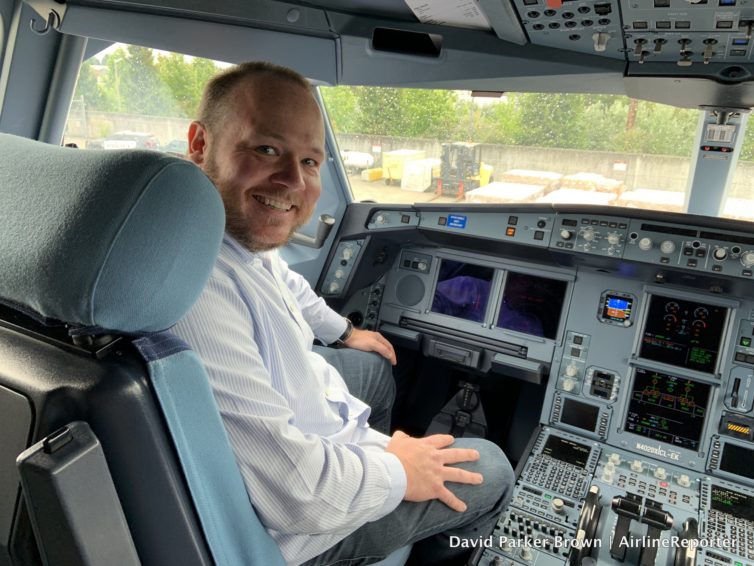
Best seat in the house… err plane!
David Parker Brown
Editor-in-Chief & Founder – Seattle, WA
@ARdpb | Flickr | YouTube | Stories Written | da***@*************er.com
David has written, consulted, and presented on multiple topics relating to airlines and travel since 2008. He has a genuine passion for sharing the complexities and benefits of the airline business. The aviation-bug got him during his first flight, when he was six months old, strapped in a baby seat in the back of a Bonanza. He has a background in higher education, public relations, entrepreneurship, and has been “blogging” since 1999.
As a bit of a Trekkie, he was quite excited when William Shatner called him an “aviation expert,” when he did a piece for his Weird of What Show in 2012. He has also earned a (good or bad) reputation for wearing a top hat, during VIP events.

Blaine loves planes, fish, and fun sweaters.
Blaine Nickeson
Managing Editor – Denver, CO
@bnickeson | Stories Written | bl****@*************er.com
Blaine is an enthusiast of all things airplanes, airlines, and miles. Due to his family being split on opposite sides of the country, Blaine traveled frequently as a child, falling in love with the flying experience, and has continued to travel ever since. For AirlineReporter, Blaine edits all content before publishing, assists in story and concept development, and takes every chance he gets to produce original content for the site. When Blaine’s not busy planning his next travel adventure, he spends his time working as a college administrator. If he can’t be on an airplane, he’d prefer to be on a bicycle or playing with his two kids and wife.
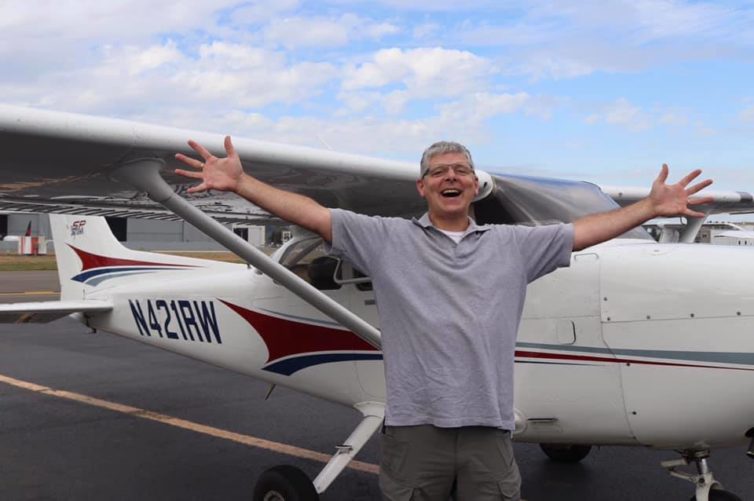
Francis learning to fly!
Francis Zera
Editor-at-Large – Seattle, WA
Francis Zera is a Seattle-based architectural, aerial, aviation, and commercial photographer, a freelance photojournalist, and a confirmed AvGeek.

JL Johnson
Managing Correspondent – Lee’s Summit, MO.
@User47 | Instagram | YouTube | Stories Written | **@*************er.com
JL joined AirlineReporter in 2012 and has since become one of our most tenured and prolific writers. His passions include catalyzing AvGeek passion in others, spending too much time on Twitter, and frequent travel. While he’s always looking for the next big adventure, home is with his growing AvGeek family in a Midwest suburb.
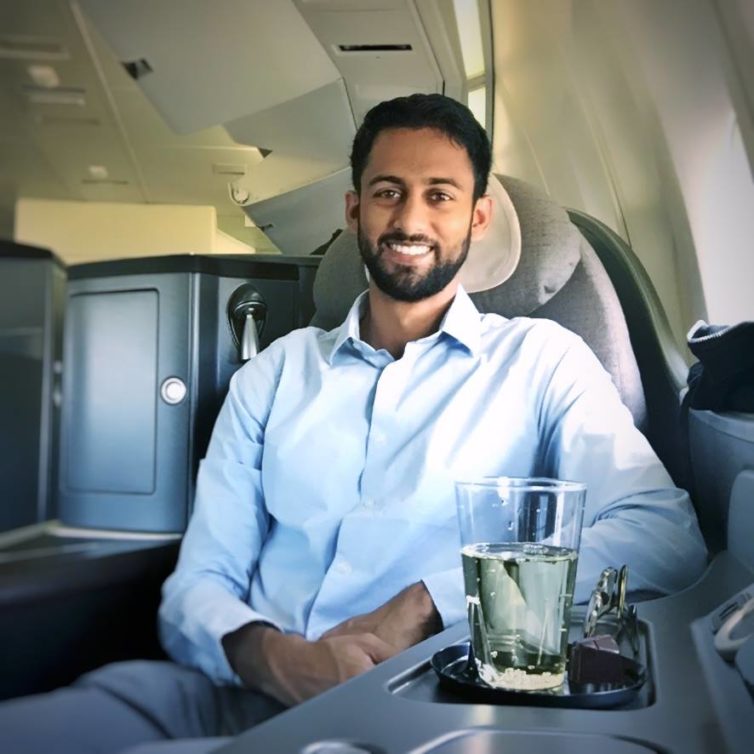
Fly time!
Manu Venkat
Senior Correspondent – New York, NY
Manu got his private pilot license in high school, setting the tone for his interest in all things aviation. He earned his frequent flyer credentials working as a journalist, and is now a medical resident in New York City. He enjoys writing about air travel from a millennial’s perspective.
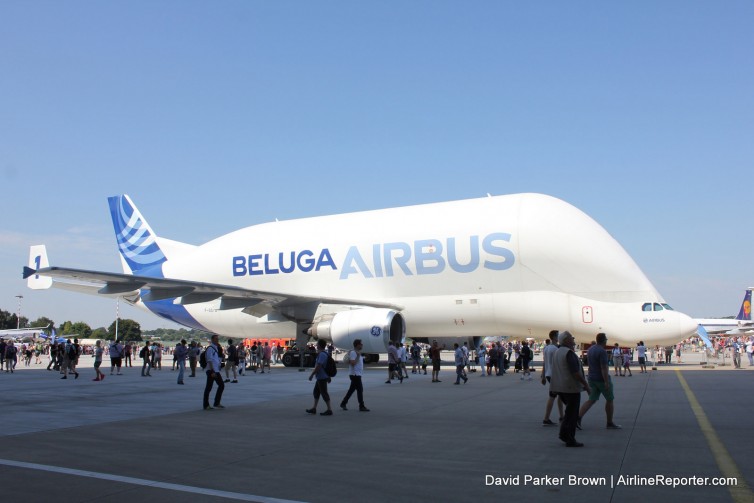
An Airbus Beluga parked in Hamburg, Germany
What is an AvGeek?
We proudly call ourselves AvGeeks and so do most of our readers. What’s an AvGeek, you ask? Here are some stories to check out:













